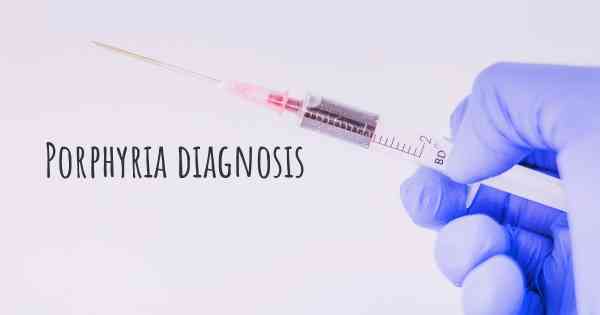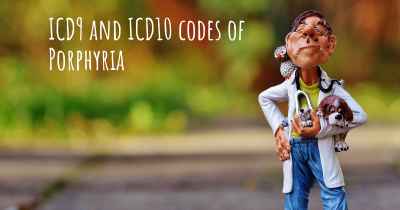How is Porphyria diagnosed?
See how Porphyria is diagnosed. Which specialists are essential to meet, what tests are needed and other useful information for the diagnosis of Porphyria

Porphyria is a group of rare genetic disorders that affect the production of heme, a component of hemoglobin that carries oxygen in the blood. These disorders are characterized by the buildup of certain chemicals called porphyrins, which can cause a wide range of symptoms. Diagnosing porphyria can be challenging due to its rarity and the variability of symptoms among different types of porphyria.
Medical History and Physical Examination:
The first step in diagnosing porphyria involves taking a detailed medical history and conducting a thorough physical examination. The healthcare provider will ask about the patient's symptoms, family history, and any known triggers or factors that worsen the symptoms. They will also perform a physical examination to look for any signs of porphyria, such as skin abnormalities or neurological deficits.
Urine and Blood Tests:
Urine and blood tests are crucial in diagnosing porphyria. The most commonly used test is the measurement of porphyrins and their precursors in the urine. A 24-hour urine collection is typically performed to assess the levels of porphyrins. Elevated levels of specific porphyrins can indicate the presence of porphyria.
In addition to urine tests, blood tests may also be conducted to measure the levels of porphyrins and other related substances. These tests can help identify the specific type of porphyria and determine the severity of the condition.
Genetic Testing:
Genetic testing plays a crucial role in diagnosing porphyria. It involves analyzing the patient's DNA to identify any genetic mutations or abnormalities associated with porphyria. Genetic testing can confirm the diagnosis and help determine the specific type of porphyria a person has.
Other Diagnostic Procedures:
In some cases, additional diagnostic procedures may be necessary to evaluate the extent of organ involvement and rule out other conditions. These procedures may include:
- Biopsy: A small sample of skin or liver tissue may be taken for examination under a microscope to detect any abnormalities.
- Electromyography (EMG): This test measures the electrical activity of muscles and can help assess any nerve damage or muscle weakness.
- Neurological Examination: A thorough evaluation of the nervous system may be performed to assess any neurological symptoms and determine their severity.
- Imaging Studies: Imaging techniques such as CT scans or MRI scans may be used to visualize any structural abnormalities or damage to organs.
Consultation with Porphyria Experts:
Due to the complexity of porphyria, it is often beneficial to consult with specialists who have expertise in diagnosing and managing these disorders. Porphyria experts, such as hematologists or geneticists, can provide valuable insights and guidance in confirming the diagnosis and developing an appropriate treatment plan.
Conclusion:
Diagnosing porphyria requires a comprehensive approach involving medical history, physical examination, urine and blood tests, genetic testing, and sometimes additional diagnostic procedures. It is essential to consult with healthcare professionals experienced in porphyria to ensure an accurate diagnosis and appropriate management of the condition.
Once diagnosed, a patient should seek care from a hematologist or other doctor specializing in porphyria.
Posted Feb 27, 2017 by Cassandra 1000
Posted Jan 12, 2018 by Mari Blignault 1500
Posted Jul 14, 2018 by Nadezda 750
Posted Mar 30, 2019 by Jocelyn 800
Posted Mar 30, 2019 by Marie 2500
With Variegate Porphyria (VP)
2.2.1- Acute neurovisceral attack +/- skin lesions
Increased urinary PBG excretion, with a plasma porphyrin fluorescence emission peak at 624-627nm. If plasma porphyrin fluorescence spectroscopy is not available or further confirmation is required, faecal porphyrin analysis shows increased protoporphyrin and, to a lesser extent, coproporphyrin concentrations with coproporphyrin III/I ratio greater than 2.0.
2.2.2- Skin lesions alone
As above, except that urinary PBG excretion is often only slightly increased or normal.
Note: urinary coproporphyrin III excretion is increased during acute and cutaneous phases but urinary analysis alone is not sufficient to establish or exclude the diagnosis of VP unequivocally.
An increased plasma porphyrin fluorescence emission peak at 624-627 nm differentiates VP from all other porphyrias. The fluorescence spectrometer used for its detection must be fitted with a red-sensitive photomultiplier and a reference range for normal plasma must be established for that spectrometer. Plasma from patients with EPP may show a fluorescence peak at around 628nm if globin from haemolysed erythrocytes is present in the sample.
Faecal protoporphyrin concentrations are usually at least 2-fold greater than coproporphyrin.
However, protoporphyrin is less fluorescent than coproporphyrin. For this reason, unless standards are used, HPLC traces may show coproporphyrin and protoporphyrin peaks of similar size.
PBG excretion is initially greatly increased during an acute attack as in AIP but may decrease to near normal levels within 7 days of onset of symptoms and become normal within 3 weeks. ALA excretion is increased to a lesser extent than PBG.
Posted May 29, 2021 by Carollynn 5770
Posted Jan 12, 2023 by Tracey 600








